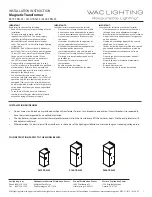
Features and Capabilities
1-3
September 2007
Theory of Operation
The XMO2 measures the concentration of oxygen in a gas mixture by
utilizing the unique paramagnetic properties of oxygen.
As its magnetic susceptibility is approximately 100 times greater than
that of most other common gases, oxygen can be easily distinguished
from these gases based on its behavior in a magnetic field. Also,
oxygen’s magnetic susceptibility varies inversely with temperature.
Therefore, by carefully combining a magnetic field gradient and a
temperature gradient within the XMO2 measuring cell, an oxygen-
containing gas mixture can be made to flow along these gradients.
This induced gas flow is known as a
magnetic wind
. The intensity of
this magnetic wind depends on the concentration of oxygen in the gas
mixture.
Figure 1-1 below shows a flow schematic for the XMO2 measuring
cell. Permanent magnets within the cell create a magnetic field, while
the cell temperature is controlled at 45°C (113°F) to maintain thermal
equilibrium. In addition, the cell contains two pairs of highly-stable,
glass-coated thermistors. One thermistor of each pair located inside
the magnetic field and the other thermistor of each pair located
outside the field. Because the thermistors are electrically heated, a
temperature gradient is thus created within the magnetic field.
Figure 1-1: Measuring Cell Flow Schematic
Induced Gas
Flow
Magnetic
Field
Upper
Measurement
Chamber
Lower
Flow-Through
Chamber
Sample
Inlet
Sample
Outlet
Wind
Receiving
(Warmed)
Thermistor
Wind
Generating
(Cooled)
Thermistor
Summary of Contents for XMO2
Page 8: ...Chapter 1 ...
Page 18: ...Chapter 2 ...
Page 30: ...Chapter 3 ...
Page 41: ...Chapter 4 ...
Page 52: ...Chapter 5 ...
Page 66: ...Chapter 6 ...
Page 114: ...Chapter 7 ...
Page 146: ...Chapter 8 ...
Page 159: ...Appendix A ...
Page 165: ...Appendix B ...
Page 177: ...Appendix C ...













































